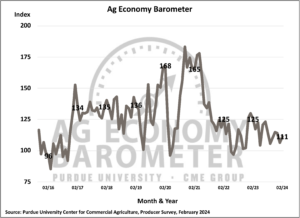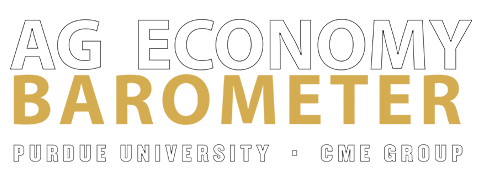Farmer sentiment improves as interest rate expectations shift
U.S. farmers’ outlook improved in March as the Purdue University/CME Group Ag Economy Barometer index rose to 114, marking a 3-point rise from February. While the Index of Current Conditions fell by 2 points to 101, the Index of Future Expectations climbed to 120, up by 5 points from February. The disparity between current and future indices was primarily influenced by farmers’ perceptions of a financial downturn taking place in the past year, coupled with some expectations for improvement over the next 12 months. The March survey was conducted from March 11-15, 2024.

Farmer sentiment improves as interest rate expectations shift. (Purdue/CME Group Ag Economy Barometer/James Mintert)
“Producers’ expectations for interest rate changes have shifted, which could help explain why producers look for financial conditions to improve,” said James Mintert, the barometer’s principal investigator and director of Purdue University’s Center for Commercial Agriculture.
This month 48% of respondents said they expect a decline in the U.S. prime interest rate over the next year, up from 35% in December. Just one-third (32%) foresee an increase compared to 43% last month. Only 20% of respondents this month identified the risk of rising interest rates as a primary concern, a decrease from the 24% recorded December 2023. High input costs continue to be producers’ number one concern, with 36% of respondents expressing worry.
The Farm Capital Investment Index increased by 7 points this month, indicating growing optimism among producers about making large investments. Producers who said it is a good time for a large investment rose to 15%, up 11% from the start of the year. This optimism is fueled by producers who pointed to strong cash flows on their farms coupled with higher dealer inventories for farm machinery. However, some producers still feel hesitant to invest due to concerns about high costs for machinery and construction and high interest rates.
Producers displayed a more optimistic short-term outlook on farmland values in March, with the Short-Term Farmland Values Index rising to 124, a 9-point increase from the previous month. This month, 38% of producers expect farmland values to increase in the coming year, compared to 31% in January and February.
“Factors contributing to this optimism included non-farm investor demand, inflation expectations and strong cash flows. An improved interest rate outlook might have been a factor as well, although producers didn’t point to that explicitly in this month’s survey,” said Mintert.
More farmers this month (24%) said they believe farmland prices will go up because of inflation expectations compared to last month (18%). There was also a slight increase in producers citing strong cash flows (8% in March versus 6% in February) as a reason, and a modest decline in the number of producers who mentioned non-farm investor demand as a major factor influencing the farmland market. However, despite this decline, 57% of producers still consider non-farm investor demand the primary reason for their bullish outlook on farmland values.
Interest in using farmland for carbon sequestration or solar energy production appears to be increasing. In this month’s survey, nearly one out of five respondents (18%) said they or their landowners had been approached about Carbon Capture Utilization and Storage (CCUS) on their farmland. Additionally, 12% of this month’s respondents said they had discussions with companies interested in leasing farmland for a solar energy project in the last six months, compared to 10% in February. When it comes to long-term farmland lease rates offered by solar energy companies, 54% of respondents this month said they were offered $1,000 or more per acre, while just over one-fourth (27%) were offered $1,250 or more per acre.
The March barometer also revealed that many farmers are concerned about potential government policy changes affecting their farms following this year’s elections. 43% of respondents anticipate more restrictive regulations for agriculture. Additionally, four out of ten (39%) producers expect taxes impacting agriculture to rise.
About the Purdue University Center for Commercial Agriculture
The Center for Commercial Agriculture was founded in 2011 to provide professional development and educational programs for farmers. Housed within Purdue University’s Department of Agricultural Economics, the center’s faculty and staff develop and execute research and educational programs that address the different needs of managing in today’s business environment.
About CME Group
As the world’s leading derivatives marketplace, CME Group (www.cmegroup.com) enables clients to trade futures, options, cash and OTC markets, optimize portfolios, and analyze data – empowering market participants worldwide to efficiently manage risk and capture opportunities. CME Group exchanges offer the widest range of global benchmark products across all major asset classes based on interest rates, equity indexes, foreign exchange, energy, agricultural products and metals. The company offers futures and options on futures trading through the CME Globex® platform, fixed income trading via BrokerTec and foreign exchange trading on the EBS platform. In addition, it operates one of the world’s leading central counterparty clearing providers, CME Clearing.
CME Group, the Globe logo, CME, Chicago Mercantile Exchange, Globex, and, E-mini are trademarks of Chicago Mercantile Exchange Inc. CBOT and Chicago Board of Trade are trademarks of Board of Trade of the City of Chicago, Inc. NYMEX, New York Mercantile Exchange and ClearPort are trademarks of New York Mercantile Exchange, Inc. COMEX is a trademark of Commodity Exchange, Inc. BrokerTec and EBS are trademarks of BrokerTec Europe LTD and EBS Group LTD, respectively. The S&P 500 Index is a product of S&P Dow Jones Indices LLC (“S&P DJI”). “S&P®”, “S&P 500®”, “SPY®”, “SPX®”, US 500 and The 500 are trademarks of Standard & Poor’s Financial Services LLC; Dow Jones®, DJIA® and Dow Jones Industrial Average are service and/or trademarks of Dow Jones Trademark Holdings LLC. These trademarks have been licensed for use by Chicago Mercantile Exchange Inc. Futures contracts based on the S&P 500 Index are not sponsored, endorsed, marketed, or promoted by S&P DJI, and S&P DJI makes no representation regarding the advisability of investing in such products. All other trademarks are the property of their respective owners.
About Purdue University
Purdue University is a public research institution demonstrating excellence at scale. Ranked among top 10 public universities and with two colleges in the top four in the United States, Purdue discovers and disseminates knowledge with a quality and at a scale second to none. More than 105,000 students study at Purdue across modalities and locations, including nearly 50,000 in person on the West Lafayette campus. Committed to affordability and accessibility, Purdue’s main campus has frozen tuition 13 years in a row. See how Purdue never stops in the persistent pursuit of the next giant leap — including its first comprehensive urban campus in Indianapolis, the new Mitchell E. Daniels, Jr. School of Business, and Purdue Computes — at https://www.purdue.edu/president/strategic-initiatives.
Writer: Erin Robinson, erobin@purdue.edu
Source: James Mintert, 765-494-7004, jmintert@purdue.edu
Media Contacts:
Aissa Good, Purdue University, 765-496-3884, aissa@purdue.edu
Dana Schmidt, CME Group, 312-872-5443, dana.schmidt@cmegroup.com


